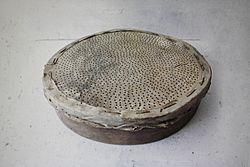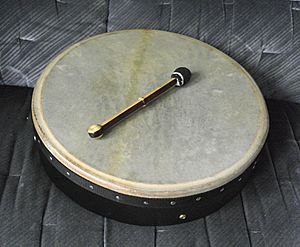Riddle drum facts for kids

A riddle sieve, which may be played as a drum
|
|
| Percussion instrument | |
|---|---|
| Classification | Frame drum |
| Hornbostel–Sachs classification | 211.311 (Directly struck membranophone) |
| Related instruments | |
|
|
|
A riddle drum is a special type of frame drum used in traditional English folk music. It's called "makeshift" because it was originally a farm tool! Farmers used large sieves, called "riddle sieves," to separate corn. These sieves were made from sheepskin stretched over a wooden frame. Farmers discovered these sieves made great percussion instruments. They even created unique rhythms and ways to play them.
When the name "Riddle Drum" was first written down in the 1950s, people only played these drums in the South of England. We don't know if other parts of England had different names for them. Or maybe the name "Riddle Drum" was used all over the country a long time ago.
Contents
What is a Riddle Drum?
The name "riddle drum" comes from an old farming task. In England, separating corn from its husks was called "riddling." Until the 1900s, farmers used special sieves for this. These "riddle sieves" had animal skin stretched over a wooden hoop. Small holes were burned into the skin to let the corn pass through.
You can find similar sieves in places like Scotland, France, and Nepal. In some countries, like Scotland, these sieves were also used to make music.
Riddle Drums in the British Isles
In Cornwall, a region in England, riddle drums had a different name. They were called "crowdy crawn." John Davey, who lived from 1812 to 1891, was one of the last people who knew the old Cornish language. He described a "crowdy crawn" as a wooden hoop covered with sheep-skin. It was used for picking up corn, but sometimes played like a tambourine.
The word "crowdy" in Cornish means "fiddle playing." "Crawn" means "animal skin." So, "crowdy crawn" literally means "fiddle playing skin."
Riddle sieves were also used in Ireland. There, they were simply called "riddles" or "English sieves." The Irish bodhrán drum looks very much like the English riddle drum. It's also made of goatskin and sometimes linked to the "riddling" of corn.
History of the Riddle Drum
Riddle drums were quite popular in Medieval Europe. You can often see them in old paintings of musicians called minstrels and troubadours. During that time, the French language was very important in European courts. So, these drums were often called "Tambour." However, we don't know if common people in England used this French word. "Tambour" can also mean any drum with just one skin, not just a riddle drum.
Some people today who make riddle drums call them "Hylsung." They think this might have been their name in Dark Ages England. Old writings from that time mention a drum called a Hylsung, but they don't describe it. Writings from Scandinavia also mention drums called Hylsung. In Scandinavia during that period, riddle drums were common. They were the only drums known to be used.
Frame drums were common across Europe until the late Middle Ages. People usually played them by holding the drum facing forward. They would use their fingers to tap the drum. Using a percussion mallet (a stick) was less common. After the Middle Ages, the riddle drum became less popular. Newer, more complex drums appeared. Only tambourines remained as a legacy of these older frame drums. Many medieval paintings show different types of frame drums.
Riddle sieves were not just found in England. Sieves made of skin for winnowing (separating grain) were used all over Europe, the Middle East, and India. But there are no records of them being used as musical instruments in other countries.
The first mention of an English sieve being played like a tambourine comes from John Davey. He described a wooden hoop covered with sheep-skin. It was used for corn but sometimes played like a tambourine, called "crowdy-crawn." However, Davey called it a tambourine, not a drum. He also didn't mention playing it with a stick. So, he might have been talking about an early version of the riddle drum.
How Riddle Drums are Made and Played
Riddle drums are a simple type of frame drum. They are usually made from a goat skin stretched over a wooden hoop. They are typically 30 to 48 centimeters (12 to 20 inches) wide. Historically, riddle drums used crude wooden frames and sheepskin. This was probably because sheep were easy to find. Modern riddle drums often use goatskin because it lasts longer. These drums usually don't have any decorations.
Frame drumming has existed since ancient times. Different countries and regions developed unique drums, playing methods, and rhythms. The riddle drum is quite different from other frame drums today. You can't easily swap it for another type of frame drum in music.
Frame drums usually have thin, tight skins. This creates high, clear sounds when played with fingers. Frame drummers often play near the edges of the drum for a higher tone. A good frame drum also has a long, ringing sound. Learning to play frame drums can be difficult. Riddle drumming, however, is fairly easy. This makes it more accessible as a folk instrument.
Riddle drum skins tend to be thicker and looser than frame drum skins. This gives them a deeper, bass sound. Players often hit the drum near the center. They might also press their free hand against the skin to make the sound shorter. This unique playing style probably developed because thin, tight skins wouldn't survive farm work. Riddle sieves were also used for other tasks. These included "filling sacks with grain, holding wool, or feathers."
Players often used a beater with two ends. They held it like a pencil. The player hits the drum with glancing blows. Sometimes they use either end of the stick, similar to how a bodhrán is played. Playing with a stick might have started because the sieves became worn out from farm work. This made them hard to play with fingers. Also, traditional English music, like jigs and hornpipes, needs a strong, clear beat. This helps dancers know when to move their feet.
Research and Revival Efforts
In the 1930s, a man named Alfie Tuck from Bridport, Dorset, was recorded playing a riddle drum with a stick. He was playing with a melodeon player. Tuck's drum was made from calfskin over a large farm sieve. He hit it with a double-ended stick. When people were step-dancing, he would wet his thumb and rub it across the drum's head to make it vibrate.
The folklorist Peter Kennedy met several riddle drummers in Dorset and Wiltshire in the 1950s and 60s. Their work helped keep the knowledge of these unique instruments alive.



